The Railway of the Pilgrims
RAILWAYS OF THE WORLD - 34
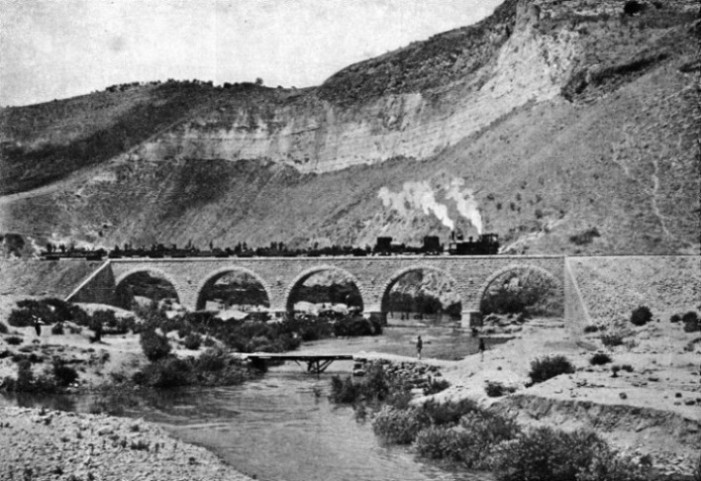
THE EL KOYE BRIDGE IN THE YARMUK VALLEY, BETWEEN HAIFA AND DERAA. This view gives a good idea of the wild ruggedness of the country through which the Hedjaz Railway passes.
THE vast majority of railways are intended for transporting passengers and merchandise from point to point to serve the ends of ordinary social and commercial life. A very small number have been built with the object of concentrating troops upon a frontier - strategic railways. One railway, and one only, owes its existence to religious motives, and that one is the Hedjaz line, which, as will be seen from our map, starts at Damascus - the Gate of Allah - and runs almost due south for more than 820 miles to Medina, the burial-place of Mohammed.
Except for a comparatively short distance at its northern end, this remarkable line traverses country so wild and sterile as to render any prospects of dividends extremely doubtful. This fact does not affect its importance, however, as the metals were laid with the express - we might almost say sole - purpose of carrying Moslem pilgrims to the holy cities of Hedjaz -Medina and Mecca - to which every Mohammedan is in duty bound to make the Hadj, or sacred journey, at least once in his lifetime, no matter how remote his country may be.
The Turks of Turkey in Europe and of Asia Minor form a very important section of the followers of the prophet, for is not the temporal head of the Ottoman Empire also the spiritual head of Islam? To reach the holy cities from the Levant a pilgrim might either make for Damascus, and thence trace, in fifty-two stages, the painful overland route through the land of Moab and Arabia Petraea, exposed to the greatest privations, scorched and parched and blistered by the sun, plundered and maimed by fierce brigands; or he might take ship to Jeddah, the Red Sea gate to the shrines of his religion. The sea voyage on a crowded, often plague-stricken ship was hardly less tedious and dangerous than the land journey; and common to both alternatives was the march through the country lying between Mecca and Medina, a rough, cruel country haunted by robber bands.
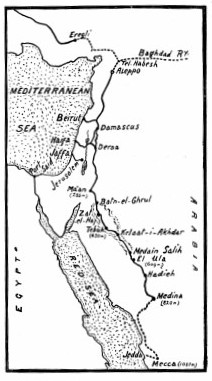
MAP SHOWING THE HEDJAZ RAILWAY. Dotted lines indicate sections under construction or projected.
The Moslem of the more rigidly orthodox type regards these trials as a worthy part of the pilgrimage - on the principle that the greater the suffering the greater is the merit. But to many of his creed, and for various reasons, a less painful access to the tomb and birthplace of Mohammed was devoutly to be desired. Moreover, the fact that Jeddah could be closed to pilgrims by a hostile fleet contained an element of religious and political danger. To reach Jeddah by sea the Moslem must thread the easily blockaded Suez Canal, which also exposed the port to easy attack by European Powers. The existence of this danger on the flank had a bad effect upon Asiatic subjects of the Sultan, who, to combat this disquieting state of affairs, conceived, in the year 1900, the idea of pushing a line from Damascus, already connected by rail with Mediterranean ports, through his own dominions to the holy cities of the Hedjaz, and so nullify a siege of Jeddah. In the future, when the line should have been linked up with the Bagdad Railway via Aleppo and Tel Habesh, an all-rail journey from the very shores of the Bosphorus would be secured.
The time was ripe for the idea. The faithful throughout the world, so far from pouring ridicule on the Sultan’s proposal, hailed it with enthusiasm. Nor were they content with words, as they poured in their subscriptions in generous measure to hasten the realization of this notable project. The Government, infected with a like spirit, handed over to the Commission appointed to carry the matter through seventeen million unused postage stamps to be sold by public auction for the good of the cause.
The rapidity with which things now moved was a revelation to those who regarded the Turk as a constitutional sluggard. The word “to-morrow” was forgotten. A wave of energy swept over the nation. The Sultan secured forthwith the services of an extremely able German engineer, Meissner Pasha, as commander-in-chief of a large working force, and selected for his lieutenants Marshal Kiazim Pasha and Haiji Mukhtar Bey; these last controlling in turn engineers of various nationalities in charge of sections - all imbued with the same enthusiastic desire to fulfil with the utmost speed the royal command.
The initial survey of the first section south from Damascus was put in hand at once. Simultaneously all preliminary arrangements were made with regard to gauge, rails, type of track to be laid down, and building equipment. The greater part of the rails and other material was purchased in Belgium, Russia, and the United States. We may mention in passing that the gauge selected was that of the line linking Damascus with the sea - one of 1·05 metres, or 41·3 inches.
Beirut was chosen as the landing-point for material for the first stage, which starts at Damascus. At the time when operations commenced, a short line, built by French capitalists, already ran southwards through a profitable agricultural belt, which may presently be very highly developed. The route chosen for the sacred railway lay almost parallel to and eastwards of the French track, as far as Deraa. This last was the natural point at which to run off a branch line to Haifa on the Mediterranean. Haifa is destined to become an important place as the sea terminus of the railway. A fine harbour is to be constructed to give safe anchorage to vessels of deep draught. On the land the visitor now sees substantial terminal buildings, surrounded by extensive sidings, and dominated by the imposing monument raised to commemorate the building of the railway.
The construction of the Haifa-Deraa section was in itself a notable undertaking. The country, rugged and broken by yawning ravines, involved the surmounting of numerous engineering difficulties. To secure the necessary easy grade the line has to follow a somewhat meandering course, especially in the neighbourhood of the deep gully through which the Jordan finds its way after leaving the Lake of Tiberias. Though the river lies 800 feet below the level of the Mediterranean, the work of carrying the rails up to the high ground on either side has been done so well that no abnormally heavy gradients are encountered.
On this 100-mile stretch, which includes seven long tunnels and a number of deep rock cuttings and large viaducts, a cosmopolitan army of workmen - Italians, Montenegrins, Greeks, Turks, and other Europeans - were kept busily at work.
After crossing the Jordan by a handsome masonry bridge of seven arches, the line bends sharply to the north-east round a bluff, and turns eastwards to effect a junction with the French Hauran Railway running south from Damascus. A sharp twist to the south-east brings the metals to a junction with the main line at Deraa. As the map shows, a round route is then established between Deraa and Damascus, over the metals of the French and Hedjaz railways, both of which have a common outlet to the sea.
As soon as this link was completed a train service was inaugurated between Haifa and Damascus; and an already considerable tourist traffic is increasing rapidly, as also the trade in agricultural produce raised in the province traversed by railway.
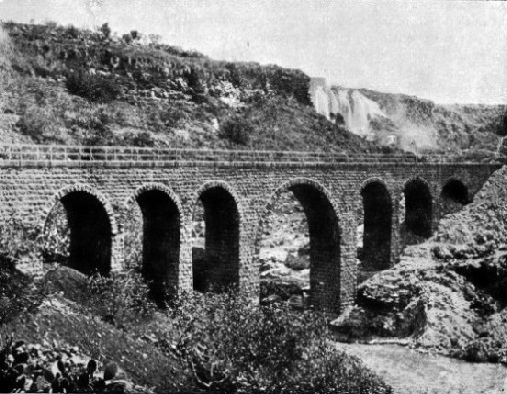
MASONRY BRIDGE AND WATERFALL IN THE TEL-EL-SHIHAB, 90 MILES FROM HAIFA.
From Deraa the line ascends gradually an undulating plateau to Zerka, where it drops into a deep valley, and climbs out of the same by a winding ascent on to another small fertile belt. As the line proceeds south-wards signs of civilization become fewer and fewer, and the sense of wild desolation more pronounced. Pursuing a course roughly parallel to the Jordan, and almost identical with the old caravan route, the railway traverses a country which is full of history and romance to the religious mind - as much so to the Christian as to the Mohammedan. Decayed ruins of a past civilization and silent monuments of a long-departed prosperity are visible on all sides.
At a point approximately abreast of the Dead Sea the railway enters a barren waste. A foot-traveller passing through this region must be astonished at encountering the steel rails and telegraph poles which mean easy communication with distant but more hospitable districts. The interminable level of sand is broken only on the western horizon, where the mountains of Moab raise their peaks dimly into the heated air.
For a considerable distance the going is easy enough from the engineering point of view. The valleys are wide, and contain no steep grades; the engineer could pick his path and lay his iron road in such a manner as to minimize the work to be exacted from the locomotives.
But in one respect the country is difficult: it is practically waterless. During construction every drop of water used by the army of workmen had to be conveyed by train from the nearest well - in some cases many miles away - and stored in jealously guarded tanks. Here and there wells have been sunk with success, and windmills, urged by the desert breezes, raise the water into cylindrical iron reservoirs perched on masonry piers, which by their shape recall the Martello towers to be seen along the south coast of England. In short, the task of supplying workmen, engines, and the pilgrims who, being too poor to take advantage of the line, still tramp the weary distance on foot, has been, and is, a problem of no mean order.
As the railway approaches Ma’an, 285 miles from Damascus, it climbs steadily on to the back of a plateau more than 3,000 feet above sea-level. Ma’an itself is now quite an important place on account of its hospital, hotel, repairing shops, and other buildings, all substantially built in stone, and designed to resist attacks by any of the rebellious tribesmen, who own a very reluctant allegiance to the Sultan, and consider their private interests to be threatened by the advent of the railway. The villagers themselves, once daring smugglers of arms and ammunition, have found a safer and equally lucrative source of revenue in the letting of their houses to railway officials and to the officers of the garrison stationed at the place, which may be regarded as the gateway of Syria, and is therefore important strategically as well as commercially. In time to come it may also find favour as a health resort, since the air, despite frequent dust storms, is very invigorating.
Southwards of Ma’an the line traverses high ground more desolate, if possible, than the country already crossed - certainly more rugged and wild. Of vegetation, except in a few little valleys, there is none; and here the transport animals of the pilgrims have perished in countless numbers. On all sides are sand, boulders, and deep ravines. About 50 miles from Ma’an, at a point where the rails have attained an elevation of 3,700 feet, the plateau ends abruptly, and there is an almost precipitous drop of 500 feet into the wild ravine called, appropriately Batn-el-Ghrul (or Batn-el-Ghoul), the Devil's Belly. Standing on the edge of the sandstone escarpment, which runs almost 40 miles east to west, the traveller has a magnificent view of the great basin-like inland depression of the south, tinted with all the colours of the spectrum. This depression extends some 120 miles to the gorge at Kelaat-el-Akhdar. Half-way down it rise the flat-topped isolated hills of the Haraat-i-Ahmar; and towards the southern end is visible the great pinnacle of the Jebel Sherora, shaped like a boar’s tusk, and towering some 2,000 feet above the plain. On both sides beetling cliffs give a sharp outline to the basin. The scene, thanks to the clear desert atmosphere, is one which lingers long in the memory of the spectator.
To the engineer the existence of the escarpment was a serious obstacle. The lower level had to be gained somehow. As time and money were alike valuable, a wide detour, which should take the ravine in flank, as it were, could not be considered. There was nothing for it but to follow the old pilgrims’ track along the very face of the cliff. By an extremely clever piece of engineering the line is carried down to the valley in a long looped curve, parallel to the face of the cliffs. So well was the work done that the grade nowhere exceeds 1·8 per cent. The descent of the ravine is undoubtedly one of the most prominent engineering features of the whole railway, and its execution reflects the highest credit on those who were responsible.
The valley gained, the railway twists in and out among rocky promontories, occasionally tunnelling through an obstacle, and at Wadi Rutm definitely enters the open depression, flanked to the east by the red and yellow sandstone bluffs 20 miles away, and on the west by the black, jagged rocks of the Red Sea watershed. In the valley have sprung up several small settlements since the coming of the railway, notably at Kalaat-i-Mudiverre, and at Zat-el-Haj. At the first of these is procurable, for the first time since leaving Ma’an, a supply of water, raised by a wind-pump from the station well; at the second is seen once more some sign of vegetation - a few palm trees. Four hundred and thirty miles from Ma’an the railway reaches Tebuk, a small oasis which had great importance as a halting-place for pilgrims. Its comparatively abundant wells have also made it an important railway depot - Ma’an on a smaller scale - equipped with engine-house, extensive sidings, and several stone buildings, of which one is a commodious hospital. When the construction parties first reached Tebuk the inhabitants were very few, as the result of a raid which had driven most of the villagers to take refuge at Ma’an and elsewhere. The name (Tebuk = “treachery”) commemorates a treacherous attack made in 629 A.D. by Bedouins on a force being led northwards by Mohammed himself to repel a rumoured Byzantine invasion of Arabia.
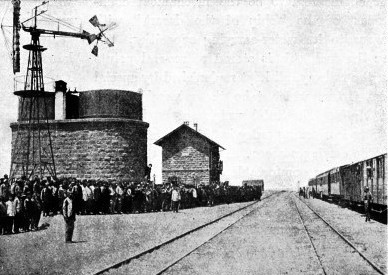
OFFICIAL OPENING OF THE TEBUK STATION. Notice the substantial character of the buildings, and the wind-pumping plant.
Shortly after leaving Tebuk the line crosses a wide gully, down which rushes occasionally a turbulent torrent; for even in this arid region rain sometimes falls, and then in torrents. The bridge, or rather viaduct, of twelve arches here is remarkable as being the only one on the line built by the Turkish soldiers.
The plain continues for some distance, and then the ranges of hills converge suddenly from either side, and close the basin. Plunging through a short tunnel, the railway emerges into a narrow valley, up which it climbs easily on a gentle gradient, and passes through extremely fine scenery to Medain Salih, near which the highest point on the line - 3,750 feet above sea-level - is attained. The section between Tebuk and Medain Salih was entrusted entirely to the military.
El Ula, 609 miles from Damascus, is possibly the most important station on the railway. Here we find a little town of four thousand souls buried in the heart of the desert. It contains five hundred houses, and boasts copious springs, and a thousand acres planted with date palms and cereals. The station, somewhat imposing and extensive, is the last depot north of Medina, and close to it are repair shops, engine-sheds, and houses for the railway staff.
Beyond El Ula the infidel may not go. Though Medina is still 210 miles away, Moslem prejudice forbids an unbeliever to approach nearer to the holy city. The journey has, indeed, been made by one or two “pagan” Europeans, but not
without great personal risk; and many years must elapse before improvements in means of communication will break down the barrier set up by the devotees of this uncompromising religion. Even Meissner Pasha himself fell under the ban, and was obliged to relegate the carrying of the rails into Medina to the very able Marshal Kiazim Pasha, who accomplished the task most creditably, aided by a band of Moslem workers.
The Turks have proved themselves very competent railway constructors. They laid the permanent way throughout, leaving only the station buildings, bridges, and culverts to workmen of other nationalities. The Turkish sailors unloaded railway material at Haifa; Turkish soldiers laid the sleepers and rails. Operations were conducted throughout on a highly organized system. Here is a little picture from the pen of one work:-
“The (construction) train carried several truck loads of rails and sleepers, and as it drew up within ten yards of the last rails laid, the working-parties, some two hundred men all told, formed up on each side of the trucks.......hard bitten picturesque fellows, wearing the agal and keffiyeh instead of the regulation fez, smaller as a rule than Egyptian conscripts, but more active and better made. There was very little shouting and no confusion; every man seemed to know what to do without orders. The rails were lifted in pairs from the trucks and set each upon the shoulders of eight men, who moved rapidly off with balanced step to the laying-point, halted, turned inwards, lowered and laid the rails with automatic precision at the orders of the squad commander, and in a moment were scampering back to the trucks to begin over again; while long strings of men hurried along the embankment with sleepers on their backs, pitched them down on the track, and rushed back as if lives depended on it for more - and all this in a temperature of 106° Fahrenheit.”*
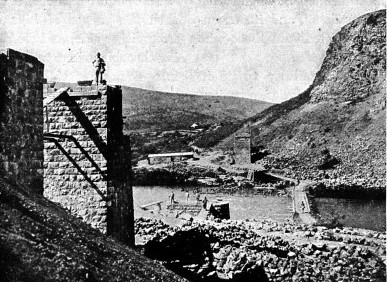
BUILDING PIERS FOR STEEL BRIDGES ON HAIFA-DERAA SECTION. The Bridge comprises two 100-foot and one central 166-foot spans.
The solidity of everything connected with this railway is one of its outstanding features. Unlike the majority of such
pioneer lines running through a sparsely populated country, it has not been built with the prime idea of getting through as quickly as possible at small cost, and reconstructing on a sounder scale afterwards. It was properly built in the first instance, and its permanent way will compare favourably with any to be found in civilized parts of the world, being ballasted with broken rock and sand, which afford a solid foundation for the rails. The bridges are in keeping with the remainder of the work; their piers of solid masonry rest on solid footings capable of withstanding the scour of turbulent rivers and the blows of floating debris carried down by floods. Where exceptionally heavy work was found to be necessary, a temporary bridge was built to carry material for the stretch of line ahead, which was laid while the permanent bridge was constructed behind it. Consequently railhead advanced uninterruptedly.
For the stone arch bridges ample supplies of material were usually found close to the site, or could be brought up easily by train. Stone was used also for the stations, which have no raised platforms, but merely paved areas on both sides of the track.
The engines used on this line are necessarily of a very powerful type, as they have to haul 250-ton trains up long grades and round sharp curves. The most notable locomotives are those of the articulated compound Mallet pattern, such as have been introduced recently upon several European and American systems. The engines have very large boiler capacity, a heating surface of 1,780 square feet, and a grate area of 27 square feet. As the rails are somewhat light, the engine’s weight is distributed over six pairs of wheels, grouped into two sets of three pairs each. The wheels of the rear group are coupled together and placed in the main frame, and driven by two high-pressure cylinders. The second and third pairs of the front group are also coupled, and driven by low-pressure cylinders fed from the high pressure. Since the forward six wheels are mounted in a pivoted bogie truck, the engine, despite its wheel base of 28 feet, is able to negotiate with safety curves of 300-foot radius at high speed. The design of the Hedjaz locomotives includes several other features rendered necessary by the peculiar characteristics of the line. Among these is the provision of unusually large tenders, able to carry five tons of coal and 4,000 gallons of water - this last obtainable, as we have noticed already, at very few places on the railway. In fact,
the engine had to be the mechanical counterpart of the “ship of the desert” with regard to its water-carrying capacities. As for the fuel, this is stored at several points on the railway, all kept replenished by special coal trains, which take the mineral aboard at Haifa. The total weight of engine and tender in working order is 89 tons.
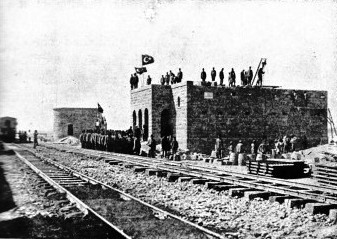
TURKISH SOLDIERS BUILDING MOAZAMMA STATION AT AN OASIS IN THE ARABIAN DESERT.
The carriages are of the American pattern, commodious, comfortable, and well slung on four-wheeled bogies. They are entered at each end by means of a short flight of steps reaching almost to the ground.
The railway was mooted by the Sultan in 1900, and completed - as far as Medina - in 1908. Considering the immense physical difficulties to be overcome, this means the achievement of a remarkable engineering feat. Practically unknown country had to be traversed. All the material, stores, and provisions for the workmen had to be brought over the rails from the seaboard. Construction included the building of some hundreds of viaducts and bridges and the driving of many tunnels. We must remember, too, that the material had all to be ordered from foreign countries - Turkey has no rail factories of her own - and that it was impossible to do what has been done on many long lines - to construct from several points simultaneously. Nor must we overlook the fact that at many points the workers were threatened by hostile tribes, and had to be protected by soldiers, whose organization put an extra tax on the resources of the authorities.
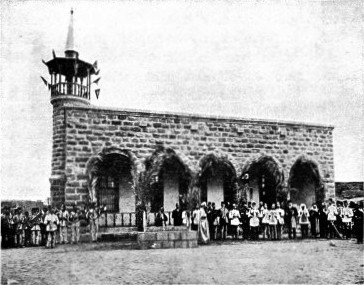
TEBUK MOSQUE, THE ONLY ONE BUILT FOR THE LINE. It was constructed by Christian workmen.
In spite of all difficulties the railway was laid well and cheaply. The total cost for the Damascus and Haifa to Medina portion was only £3,000,000, or about £30,000 per mile. The lowness of the figures is due in no small degree to the fact that for once Turkish greed was subordinated to religious motives, so that all the money subscribed for the railway was used for that purpose. This renunciation is in itself sufficient to render the Hedjaz scheme a memorable feature of the Ottoman Empire.
It remains to lay 285 miles of track across the desert from Medina to Mecca. The work is being pushed forward with unabated vigour, and soon it will be possible for Moslems to travel to that - in the eyes of the unbeliever - mysterious city with speed and in such comfort as the pilgrim of other days could hardly conceive as existing outside his Paradise. When the Bagdad Railway has progressed another 200 miles, and the Bosphorus has been spanned by a bridge, Mecca will be in direct communication with Constantinople itself, and the influence of the Sultan must necessarily increase among the Arabian tribes who at present refuse him fealty. Looking still further into the future, we see the great land of Arabia, as yet largely unexplored by Europeans, thrown open to the tourist, who will book right through to it from Paris, Berlin, Vienna, and other great continental cities.
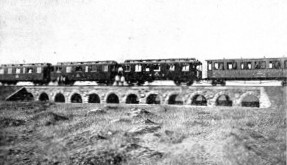
VADI PTIL BRIDGE. The only one built by Turkish soldiers.
* The Times.
You can read more on “In Northern Africa”, “Railways in Palestine” and “The Taurus Express” on this website.










